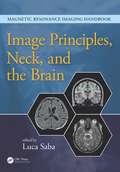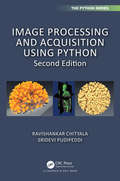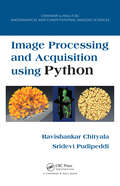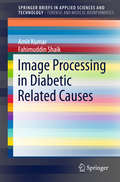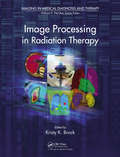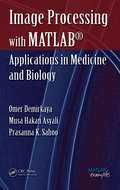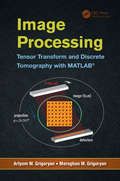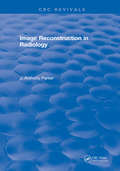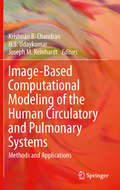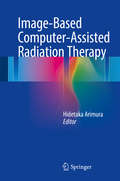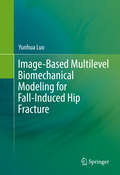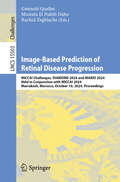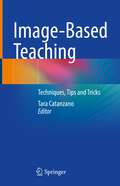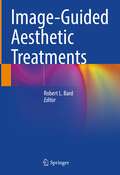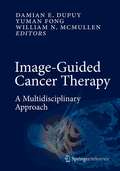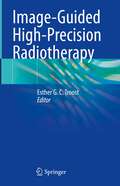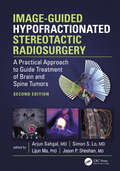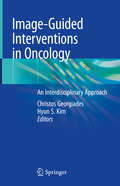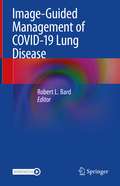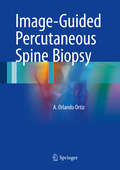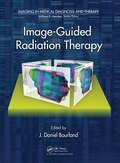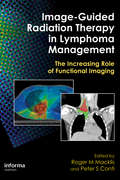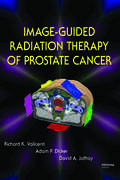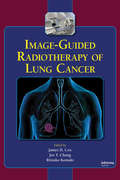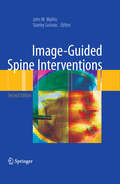- Table View
- List View
Image Principles, Neck, and the Brain
by Luca SabaMagnetic resonance imaging (MRI) is a technique used in biomedical imaging and radiology to visualize internal structures of the body. Because MRI provides excellent contrast between different soft tissues, the technique is especially useful for diagnostic imaging of the brain, muscles, and heart.In the past 20 years, MRI technology has improved si
Image Processing and Acquisition using Python (Chapman & Hall/CRC The Python Series)
by Ravishankar Chityala Sridevi PudipeddiImage Processing and Acquisition using Python provides readers with a sound foundation in both image acquisition and image processing—one of the first books to integrate these topics together. By improving readers’ knowledge of image acquisition techniques and corresponding image processing, the book will help them perform experiments more effectively and cost efficiently as well as analyze and measure more accurately. Long recognized as one of the easiest languages for non-programmers to learn, Python is used in a variety of practical examples. A refresher for more experienced readers, the first part of the book presents an introduction to Python, Python modules, reading and writing images using Python, and an introduction to images. The second part discusses the basics of image processing, including pre/post processing using filters, segmentation, morphological operations, and measurements. The second part describes image acquisition using various modalities, such as x-ray, CT, MRI, light microscopy, and electron microscopy. These modalities encompass most of the common image acquisition methods currently used by researchers in academia and industry. Features Covers both the physical methods of obtaining images and the analytical processing methods required to understand the science behind the images. Contains many examples, detailed derivations, and working Python examples of the techniques. Offers practical tips on image acquisition and processing. Includes numerous exercises to test the reader’s skills in Python programming and image processing, with solutions to selected problems, example programs, and images available on the book’s web page. New to this edition Machine learning has become an indispensable part of image processing and computer vision, so in this new edition two new chapters are included: one on neural networks and the other on convolutional neural networks. A new chapter on affine transform and many new algorithms. Updated Python code aligned to the latest version of modules.
Image Processing and Acquisition using Python (Chapman And Hall/crc Mathematical And Computational Imaging Sciences Ser.)
by Ravishankar Chityala Sridevi PudipeddiImage Processing and Acquisition using Python provides readers with a sound foundation in both image acquisition and image processing-one of the first books to integrate these topics together. By improving readers' knowledge of image acquisition techniques and corresponding image processing, the book will help them perform experiments more effectiv
Image Processing in Diabetic Related Causes
by Amit Kumar Fahimuddin ShaikThis book is a collection of all the experimental results and analysis carried out on medical images of diabetic related causes. The experimental investigations have been carried out on images starting from very basic image processing techniques such as image enhancement to sophisticated image segmentation methods. This book is intended to create an awareness on diabetes and its related causes and image processing methods used to detect and forecast in a very simple way. This book is useful to researchers, Engineers, Medical Doctors and Bioinformatics researchers.
Image Processing in Radiation Therapy (Imaging in Medical Diagnosis and Therapy)
by Kristy K. BrockImages from CT, MRI, PET, and other medical instrumentation have become central to the radiotherapy process in the past two decades, thus requiring medical physicists, clinicians, dosimetrists, radiation therapists, and trainees to integrate and segment these images efficiently and accurately in a clinical environment. Image Processing in Radiation
Image Processing with MATLAB: Applications in Medicine and Biology
by Omer Demirkaya Musa H. Asyali Prasanna K. SahooImage Processing with MATLAB: Applications in Medicine and Biology explains complex, theory-laden topics in image processing through examples and MATLAB algorithms. It describes classical as well emerging areas in image processing and analysis. Providing many unique MATLAB codes and functions throughout, the book covers the theory of probability an
Image Processing: Tensor Transform and Discrete Tomography with MATLAB ®
by Artyom M. Grigoryan Merughan M. GrigoryanFocusing on mathematical methods in computer tomography, Image Processing: Tensor Transform and Discrete Tomography with MATLAB® introduces novel approaches to help in solving the problem of image reconstruction on the Cartesian lattice. Specifically, it discusses methods of image processing along parallel rays to more quickly and accurately reconstruct images from a finite number of projections, thereby avoiding overradiation of the body during a computed tomography (CT) scan. The book presents several new ideas, concepts, and methods, many of which have not been published elsewhere. New concepts include methods of transferring the geometry of rays from the plane to the Cartesian lattice, the point map of projections, the particle and its field function, and the statistical model of averaging. The authors supply numerous examples, MATLAB®-based programs, end-of-chapter problems, and experimental results of implementation. The main approach for image reconstruction proposed by the authors differs from existing methods of back-projection, iterative reconstruction, and Fourier and Radon filtering. In this book, the authors explain how to process each projection by a system of linear equations, or linear convolutions, to calculate the corresponding part of the 2-D tensor or paired transform of the discrete image. They then describe how to calculate the inverse transform to obtain the reconstruction. The proposed models for image reconstruction from projections are simple and result in more accurate reconstructions. Introducing a new theory and methods of image reconstruction, this book provides a solid grounding for those interested in further research and in obtaining new results. It encourages readers to develop effective applications of these methods in CT.
Image Reconstruction in Radiology
by J. A. ParkerThis one-of-a-kind resource provides a very readable description of the methods used for image reconstruction in magnetic resonance imaging, X-ray computed tomography, and single photon emission computed tomography. The goal of this fascinating work is to provide radiologists with a practical introduction to mathematical methods so that they may better understand the potentials and limitations of the images used to make diagnoses. Presented in four parts, this state-of-the-art text covers (1) an introduction to the models used in reconstruction, (2) an explanation of the Fourier transform, (3) a brief description of filtering, and (4) the application of these methods to reconstruction. In order to provide a better understanding of the reconstruction process, this comprehensive volume draws analogies between several different reconstruction methods. This informative reference is an absolute must for all radiology residents, as well as graduate students and professionals in the fields of physics, nuclear medicine, and computer-assisted tomography.
Image-Based Computational Modeling of the Human Circulatory and Pulmonary Systems
by Krishnan B. Chandran Joseph M. Reinhardt H. S. UdaykumarImage-Based Computational Modeling of the Human Circulatory and Pulmonary Systems provides an overview of the current modeling methods and applications enhancing interventional treatments and computer-aided surgery. A detailed description of the techniques behind image acquisition, processing and three-dimensional reconstruction are included. Techniques for the computational simulation of solid and fluid mechanics and structure interaction are also discussed, in addition to various cardiovascular and pulmonary applications. Engineers and researchers involved with image processing and computational modeling of human organ systems will find this a valuable reference.
Image-Based Computer-Assisted Radiation Therapy
by Hidetaka ArimuraThis book provides a comprehensive overview of the state-of-the-art computational intelligence research and technologies in computer-assisted radiation therapy based on image engineering. It also traces major technical advancements and research findings in the field of image-based computer-assisted radiation therapy. In high-precision radiation therapies, novel approaches in image engineering including computer graphics, image processing, pattern recognition, and computational anatomy play important roles in improving the accuracy of radiation therapy and assisting decision making by radiation oncology professionals, such as radiation oncologists, radiation technologists, and medical physicists, in each phase of radiation therapy. All the topics presented in this book broaden understanding of the modern medical technologies and systems for image-based computer-assisted radiation therapy. Therefore this volume will greatly benefit not only radiation oncologists and radiologists but also radiation technologists, professors in medical physics or engineering, and engineers involved in the development of products to utilize this advanced therapy.
Image-Based Multilevel Biomechanical Modeling for Fall-Induced Hip Fracture
by Yunhua LuoFall-induced hip fracture is an epidemic health risk among elderly people. This book presents an image-based multilevel modeling approach to understanding the biomechanics involved in fall-induced hip fracture. By hierarchically integrating a body-level dynamics model, a femur-level finite element model, and a local bone failure model, the biomechanics approach is able to simulate all stages in sideways falls and to incorporate all biomechanical variables affecting hip fracture. This book is useful for clinicians to accurately evaluate fracture risk, for biomechanical engineers to virtually test hip protective devices, and for biomedical students to learn image-based biomechanical modeling techniques. This book also covers: Biomechanical viewing on bone composition, bone remodeling, and bone strength Bone imaging and information captured for constructing biomechanical models Bone mechanical testing and mechanical properties required for biomechanical modeling
Image-Based Prediction of Retinal Disease Progression: MICCAI Challenges, DIAMOND 2024 and MARIO 2024, Held in Conjunction with MICCAI 2024, Marrakesh, Morocco, October 10, 2024, Proceedings (Lecture Notes in Computer Science #15503)
by Gwenolé Quellec Mostafa El Habib Daho Rachid ZeghlacheThis book constitutes the proceedings from the MICCAI Challenges, Device-Independent Diabetic Macular Edema Onset Prediction, DIAMOND 2024, and Monitoring Age-Related macular degeneration progression in Optical coherence tomography, MARIO 2024, held in conjunction with the 27th International conference on Medical Image Computing and Computer Assisted Intervention, MICCAI 2024, in Marrakesh, Morocco in October 2024. The 15 papers included in this book from MARIO 2024 were carefully reviewed and selected from 17 submissions, whereas the 6 papers included here from DIAMOND 2024 were carefully reviewed and selected from 8 submissions. These papers focus on a wide range of state-of-the-art deep learning approaches to derive patient specific rules for Diabetic retinopathy (DR) and age-related macular degeneration (AMD) progression prediction from retinal images.
Image-Based Teaching: Techniques, Tips and Tricks
by Tara CatanzanoThis book offers detailed information on a variety of teaching techniques for radiology. Generational differences in communication and adult learning theory have led to changes in educational content delivery. Traditional didactic teaching methods are no longer embraced by students, requiring educators to learn and adopt new techniques. Radiologists currently in practice have little or no experience with these newer techniques, some thrust upon them abruptly by the COVID pandemic. In addition to practicing radiologists, the next generation of educators are currently in training and often do not receive instruction on educational theory and teaching techniques. It is incumbent upon members of the educational sphere to provide resources for these individuals. This work intends to provide just such a resource.The objectives of the book include: Explaining adult learning theory and brain-friendly teachingDescribing teaching techniques to leverage brain-friendly teachingReinforcing key points with links to online video-based lectures as an accompaniment to the text Topics covered across chapters include helping non-teaching faculty to teach, writing high quality MCQ questions, and teaching quality, safety, and professionalism. Each chapter will have one “key takeaway” chart at the conclusion of the chapter with high-yield key points highlighted in a bulleted format.This is an ideal guide for practicing radiologists, including those not currently working in academic centers. Faculty in non-academic centers can specifically benefit from chapters related to medical student, clinician and patient education. Future academic radiologists (i.e., fellows and residents) can benefit from the text as a foundation for careers in teaching hospitals and academic medical centers.
Image-Guided Aesthetic Treatments
by Robert L. BardThis book offers a detailed and up-to-date overview of image-guided aesthetic treatments. A wide range of aesthetic image-guided procedures in different body regions are described in more than twenty chapters. For each procedure, the benefits of image guidance are identified and its use is clearly explained. The coverage includes all the major tools commonly employed by today’s aesthetic and plastic surgeons, such as spectral imaging, laser, microfocused ultrasound, and radiofrequency technologies. Image guidance of aesthetic treatments has a variety of benefits: Image-guided treatment by means of non-surgical or minimally invasive modalities greatly reduces patient anxiety and the likelihood of postoperative disfigurement. Image guidance allows the physician to measure the skin thickness and the depth of fat tissue and to evaluate the elasticity of the skin and subcutaneous tissues, improving thermal treatment outcomes. It can also map the arteries, veins, and nerves, thereby providing preoperative landmarks and permitting reduction of postoperative bleeding and avoidance of nerve damage. Furthermore, imaging can non-invasively identify subdermal fillers or implants, assisting in the identification of migration with attendant vascular compromise or nerve entrapment. Image-Guided Aesthetic Treatments will be a valuable guide and reference not only for aesthetic practitioners, plastic surgeons, and other specialists, but also for imaging technicians and interested laypersons.
Image-Guided Cancer Therapy: A Multidisciplinary Approach
by Yuman Fong Damian E. Dupuy William N. McmullenImage-Guided Cancer Therapy: A Multidisciplinary Approach provides clinicians with in-depth coverage of the growing, dynamic field of interventional oncology. Combining the knowledge of expert editors and authors into one powerhouse reference, this book looks at tumor ablation, HIFU, embolic therapies, emerging technologies, and radiation therapy throughout the body (liver, bone, breast, gynecologic and prostate cancers, to name just a few) , and includes discussion of different imaging modalities. In the words of Peter Mueller, MD, author of the book's Foreword: "... The senior authors are all world renowned experts in interventional oncology, which is another example of the high quality authorship and experience that is brought to this book. The later chapters discuss therapies that are simply not covered in any other source. Everyone who is doing or wants to do ablation therapies and interventional oncology will face a time when they will be asked to use their expertise in less used and less investigated areas. There is nowhere else where the reader can get information on the prostate, breast, and gynecologic areas, and especially pediatrics....This book is an outstanding contribution to the literature and will become a 'must read' for all physicians who are interested in Interventional Oncology."
Image-Guided High-Precision Radiotherapy
by Esther G. C. TroostThis book equips readers with detailed knowledge on the current status of image-guided radiotherapy with photons and particles and highlights issues that need to be addressed in order to further improve treatment outcomes. The opening chapters cover clinical and technical aspects of target volume definition using anatomic (computed tomography and magnetic resonance imaging; MRI) as well as functional (MRI and positron emission tomography) imaging. Up-to-date information is then provided on the full range of image-guided high-precision radiotherapy techniques, including IMRT/VMAT, stereotactic body radiation therapy, MR-guided linear accelerators, MR-guided brachytherapy, and particle therapy. The role of ultrasonography in image-guided radiotherapy is discussed, as are the available means for target volume demarcation and stabilization and adaptive radiation therapy. Finally, outcome evaluation is explored in depth, with a particular focus on the role of multimodality imaging in predicting tumor control and normal tissue toxicity. The authors are experts in different specialties and the book will be of high value for radiation oncologists, medical physicists, radiologists, nuclear medicine physicians, and radiation technicians.
Image-Guided Hypofractionated Stereotactic Radiosurgery: A Practical Approach to Guide Treatment of Brain and Spine Tumors
by Arjun SahgalFollowing recent developments in hypofractionated stereotactic radiation therapy (SRT) for brain and spine tumors, this new edition offers a fully updated and comprehensive "how-to" guidance on hypofractionated SRT for brain and spine metastases, glioma, benign tumors, and other tumor types. Presenting the state of the art of the technology and practice, this book: • Discusses the pros and cons of hypofractionated SRT compared to single-fraction radiosurgery, providing a deeper understanding of radiosurgery and radiobiology • Explains the toxicity and adverse effects of hypofractionated SRT including the dosage of 24 Gy in two spine SBRT fractionation schemes, aiding practitioners in communicating the risks and benefits of treatment and in obtaining consent from their patients• Outlines the current standards for safe practice, including checklists for implementation• Explores new technologies for brain and spine tumors including LITT, MR-guided focused ultrasound, and Zap technology, with chapters authored by well-recognized experts in the radiation, oncology, and neurosurgery communities; this book delivers a level of technological and clinical detail not available in journal papers This book is suitable for radiation oncologists, neurosurgeons, and medical physicists who specialize in brain and/or spine radiosurgery or want to start a program and need a comprehensive reference with key checklists for practice.
Image-Guided Interventions in Oncology: An Interdisciplinary Approach
by Christos Georgiades Hyun S. KimThis book provides an up-to-date and comprehensive primer on image-guided interventions for cancer. Image-guided interventional oncology is gaining popularity as it is a minimally invasive and more precisely targeted approach that both proves more effective and results in fewer side effects. This book’s aim is to provide a clinical guide to interventional oncology for the entire oncology team. Chapters are approached with the same interdisciplinary perspective that is used in the care itself, with each chapter written by an interventional radiologist with contributions from medical, surgical and/or radiation oncologists. Chapters cover the major cancers that can benefit from interventional oncology treatment (including lung, liver, kidney, and bone), as well as some of the physics and physiology behind these interventional modalities. This is an ideal guide for interventional radiologists, medical oncologists, surgical oncologists, radiation oncologists, as well as relevant trainees.
Image-Guided Management of COVID-19 Lung Disease
by Robert L. BardThis book offers a detailed and up-to-date overview of image-guided diagnostics in COVID-19 lung disease. A range of image-guided CT and ultrasound procedures in different chest regions are described. For each procedure, the benefits of image guidance are presented and its specialized application explained in the adult (outpatient, triage and hospital setting) and the pediatric patient. Lung Ultrasound Image Guidance assesses this rapidly evolving disease in real time while CT scans may be precisely targeted. The editor provides his 50+ year experience of multidisciplinary chest imaging including battlefield experience to optimally combat this recent viral assault. Image-Guided Management will be a valuable guide and reference not only for radiologists and pulmonary practitioners, but also for imaging technicians and First Responders. The intense public interest in safety and prevention is covered in the chapters on protection and decontamination. A chapter addressing the multiplicity of organ damage is useful for cardiologists and internists given the long differential diagnosis of respiratory distress entities. The emergence of point of care ultrasound providing 24/7 diagnostic access into inflammatory processes of the lung heralds its ascendance to the top tier of acute care diagnostic tools.
Image-Guided Percutaneous Spine Biopsy
by A. Orlando OrtizThis textbook covers key areas and reviews important principles and steps in the preparation for and the performance of spine biopsy. Image-guided percutaneous biopsy techniques and their application throughout the spinal axis are presented and discussed in detail. The advantages and disadvantages of various spine biopsy instruments are reviewed. Commonly encountered biopsy scenarios are considered in order to help readers effectively manage these situations when they occur in their practices. Clear guidance is offered on patient selection and preparation, which are critical to safe and effective outcomes, and much emphasis is placed on procedural safety, with a focus on complication avoidance and the appropriate reporting of complications. Image-Guided Percutaneous Spine Biopsy will be a welcome one-stop shop providing up-to-date information for all physicians with an interest in the subject, including radiologists, surgeons, and pathologists.
Image-Guided Radiation Therapy (Imaging in Medical Diagnosis and Therapy)
by J. Daniel BourlandImage-Guided Radiation Therapy presents key image-guided radiation treatment (IGRT) technologies for external beam radiotherapy. The book explores the decades-long technological developments that have occurred in the realm of image-guided conformal, customized radiation treatment. Expert authors, all of whom have actively participated in the develo
Image-Guided Radiation Therapy in Lymphoma Management: The Increasing Role of Functional Imaging
by Roger M Macklis Peter S ContiAn ideal text for radiation oncologists, hematologist-oncologists, and radiologists, Image-Guided Radiotherapy and Functional Imaging in Modern Lymphoma Management is the foremost source for information on the increasingly important subject of image guided radiation therapy (IGRT) and its crucial role in the clinical evolution of high-precision ion
Image-Guided Radiation Therapy of Prostate Cancer
by David A. Jaffray Richard K. Valicenti Adam P. DickerAnswering the need that exists for a single reference to address the practical issues of implementing Image-guided Radiation Therapy (IGRT) into prostate cancer treatment, Image-guided Radiation Therapy of Prostate Cancer provides clinicians with a solid understanding of this technology and, through in-depth illustrations and step-by-step guideline
Image-Guided Radiotherapy of Lung Cancer
by Ramjee PrasadLung cancer is the leading cause of cancer death in the United States, but IGRT (image guided radiation therapy) offers the possibility of more aggressive and enhanced treatments. The only available source on the subject that emphasizes new imaging techniques, and provides step-by-step treatment guidelines for lung cancer, this source helps clinici
Image-Guided Spine Interventions
by Stanley Golovac John M. MathisHere is the second, completely revised and updated edition of the successful practical guide to image-guided spine intervention. It contains revised text and images as well as new sections and chapters. The updated text thoroughly discusses both well-established and new interventions that are applied to the spine for the purpose of pain relief.
